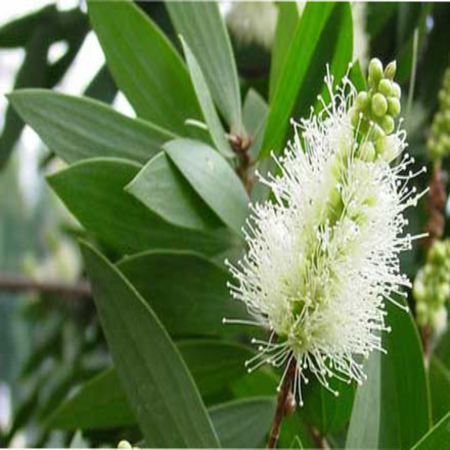

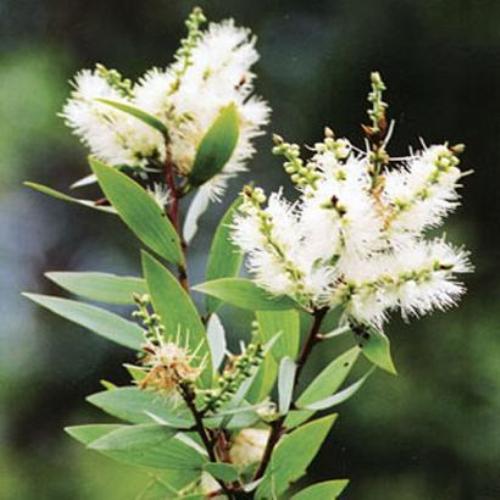
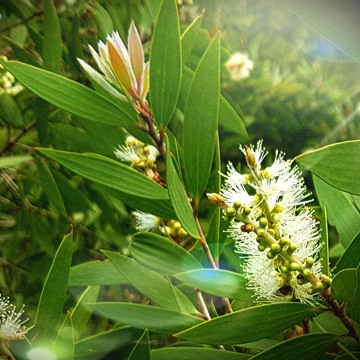
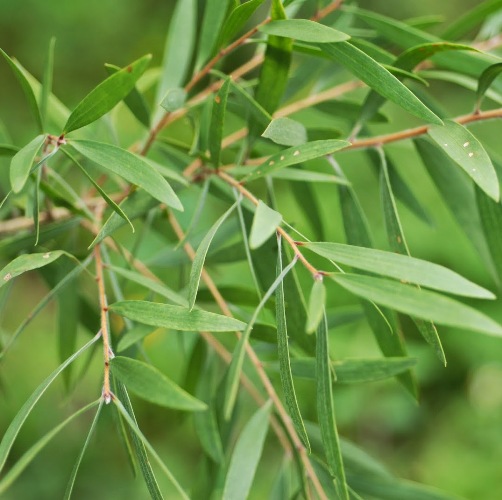
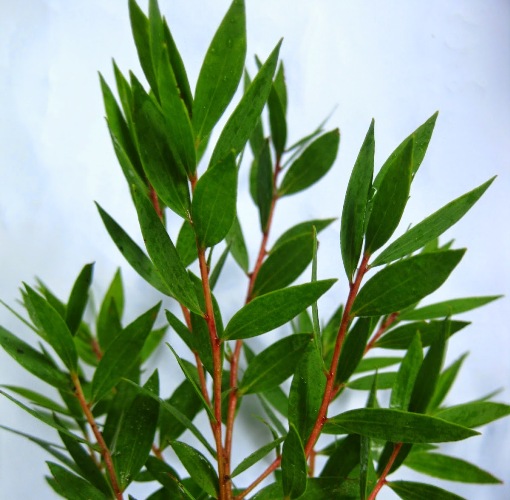
Botanical name Melaleuca cajuputi Powell
Botanical synonym Melaleuca leucadendron var. cajuputi Roxb.
Synonyms Cajeput, river tea tree, swamp tea tree, weeping tea tree, punk tree.
Family Myrtacea
Source Leaves and twigs
Origin Indonesia
Description / Color / Consistency A pale yellow, sometimes with a green tint-white mobile liquid having Fresh, mint,amphoraceous odour
Aromatic Summary / Note / Strength of Aroma Cajeput Essential Oil has a fresh, camphorous aroma resembling the combined fragrances of camphor, rosemary, and cardamom, with a slight fruity note; a middle note with a medium strength aroma.
Blends With Cedarwood, Clove Bud, Labdanum Origanum, Rosemary, and Thyme.
Product Abstract
Cajeput tree is related to the tea tree as they are from the same genus, Melaleuca. It can be found in shorelines on the island of Pulau Buru in Maluku and in some parts of Central Java. Cultivation is not needed as removing a tree creates rapid re growth of the tree and it tends to crowd out all other trees in the area.
Primarily used in massage oils, it is also used for its remedial qualities in treating stomach aches, common cold, nausea and insect bites. More than 90% of the oil produced is consumed locally by the pharma industry. Cajeput has been known to be used to overcome a lack of energy and renew a zeal for life.
History
It is known in ancient India as Kayaputi and was also revered in the East for all its uses. Cajeput has stood tall and is a time tested remedy for respiratory and sinus related infections since thousands of years.
Harvesting/Extraction Information
Cajeput is a small tree with a soft, thick, spongy, ash-colored bark and scattered branches, with the slender twigs often drooping likethe weeping willow (Salix babylonica). The leaves are from 3 to 5 inches long, and very aromatic when bruised. An evergreen, vigorous growing tree, it can reach 30 meters (98 feet) and has a whitish spongy bark with a crooked trunk.
Cajuput essential oil is extracted from fresh leaves and twigs by steam distillation.
Common Usage
Cautions
Cajuput is a very powerful oil and should be used with care. Very effective at stimulating and clearing the body but when over used can irritate the skin membrane and mucous membrane and cause headaches.
Key constituents
1,8-Cineole 41.1–70.8%
a-Terpineol 6.5–8.7%
p-Cymene 0.7–6.8%
Terpinolene 0–5.9%
g-Terpinene 1.2–4.6%
(þ)-Limonene 3.8–4.1%
Linalool 2.7–3.6%
a-Pinene 2.1–3.2%
b-Caryophyllene 0.7–2.5%
b-Myrcene 0.9–2.0%
a-Caryophyllene 0.5–1.6%
b-Pinene 0.8–1.5%
Terpinen -4-ol 0.6–1.5%
b-Selinene 0–1.5%
a-Selinene 0–1.5%
Guaiol 0–1.2%
Quality
Eucalyptus oil may be added or substituted, as may oils from M. quinquenervia or M. symphyocarpa. Fixed oils or kerosene are occasionally used as adulterants .
Safety summary
Hazards Essential oils high in 1,8-cineole can cause CNS and breathing problems in young children.
Contraindications Do not apply to or near the face of infants or children.
Organ-specific effects
Adverse skin reactions Undiluted cajuput oil was not irritating to the skin of rabbits, mice or pigs; tested at 4% on 25 volunteers it was neither irritating nor sensitizing. It is non-phototoxic. 1,8-Cineole presents a low risk of both skin irritation and sensitization.
Reproductive toxicity The low reproductive toxicity of 1,8- cineole, (þ)-limonene, linalool and a-pinene suggests that cajuput oil is not hazardous in pregnancy.
Systemic effects
Acute toxicity (human) 1,8-Cineole has been reported to cause serious poisoning in young children when accidentally instilled into the nose.
Acute toxicity (animal) Cajuput oil acute oral LD50 in rats 3.87 g/kg; acute dermal LD50 in rabbits >5 g/kg
Carcinogenic/anticarcinogenic potential No information found. 1,8-Cineole is non- mutagenic and shows no evidence of carcinogenesis in rodents.
Comments
Cajuput oil was formerly thought to originate from Melaleuca leucadendra L. It is commercially produced in Vietnam, China and Indonesia.